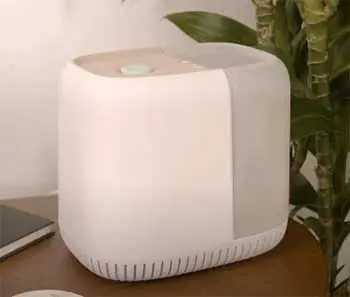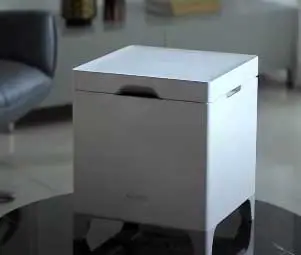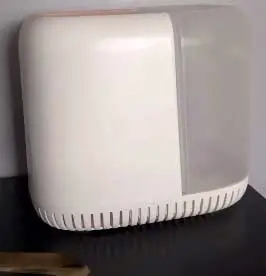Humidity levels can make a big difference in comfort and health, especially during dry winter months. Adding moisture to the air can relieve respiratory issues, dry skin, static electricity, and more. Humidifiers are an easy way to increase humidity at home, but with so many types and brands available, how do you choose?
Two popular options are the Canopy humidifier and CarePod humidifier. They take very different approaches to humidifying, so let’s take an in-depth look at how they compare.
Key Differences At A Glance
| Feature | Canopy | CarePod |
| Type of humidifier | Evaporative | Ultrasonic cool mist |
| Coverage capacity | 500 sq ft | 320 sq ft |
| Water tank capacity | 1.3 gallons | 1 gallon |
| Runtime per refill | 60 hours | Up to 36 hours |
| Weight | 12 lbs | 7 lbs |
| Noise level | Near silent | 35 dB on low |
| Smart features | App control, Alexa compatible | Digital humidistat, auto shut-off |
Looking at this high-level comparison, you can already see some key differences. The Canopy relies on a natural evaporative process to humidify, while the CarePod uses ultrasonic technology to disperse a cool mist.
The Canopy has a larger tank capacity, longer runtime, and can cover more square footage. But the compact CarePod is more affordable and has handy smart features built-in.
Keep reading for more in-depth examination of how these humidifiers work, what they do well, and where they fall short.
How Do Canopy And Carepod Humidifiers Work?
Understanding the technology inside a humidifier can help you determine if it will work well for your needs and environment.
Canopy
The Canopy uses an evaporative system to naturally humidify. Here is how it works:

- A large 1.3 gallon tank is filled with water and inserted into the base. This tank supplies water to the wicking filter.
- The filter sits above an internal fan which draws air into the humidifier.
- As air passes through the damp filter, moisture evaporates into the air naturally. This evaporation process adds cool, clean humidity to the room.
- Excess water drips back down into the tank to recirculate. There is no mist dispersed into the room.
A huge benefit of Canopy’s evaporative technology is that minerals and contaminants are left behind in the water tank instead of getting dispersed into the air. So you get clean, pure humidity.
CarePod
In contrast, the CarePod relies on ultrasonic technology:
- A 1 gallon water tank supplies water to the basal well where an ultrasonic disc vibrates at a high frequency.
- This rapid vibration disperses the water into a cool mist containing ultra-fine water droplets.
- A small fan helps circulate this moisture-rich mist into the room to increase humidity.
- Excess water returns back to the tank.
The CarePod adds needed humidity by actively dispersing a visible mist. This makes it easy to confirm it’s working. But minerals and contaminants in tap water do get released into the air.
Key Differences Between Canopy And CarePod Humidifiers
- Coverage Capacity
An important consideration is how much square footage a humidifier can effectively service. Both the Canopy and CarePod are made for medium-sized rooms.
Canopy
With its large tank capacity and evaporative filtration system, Canopy humidifiers are rated to cover up to 500 square feet. This makes it a great option for master bedrooms, nurseries, offices, and living spaces. The evaporative technology means it runs very quietly too, so it won’t disturb your sleep.
CarePod

In contrast, the ultrasonic CarePod has a more limited humidifying capacity of 320 square feet.
It’s a better fit for single bedrooms, kids’ rooms, and small offices.
And since ultrasonic models do produce some noise from the vibrating disc and mist dispersion, it may not be the best pick for bedrooms.
- Runtime Per Refill
Nobody wants to be refilling their humidifier multiple times a day. Comparing runtime per refill shows how convenient and efficient different models are over extended use.
Canopy
The Canopy humidifier can run for a whopping 60 hours between refills. That’s over 2 days of continuous runtime. The large 1.3 gallon tank simply doesn’t need refilled very often, even when humidifying spaces up to 500 square feet. This exceptional runtime makes Canopy extremely low-maintenance.
CarePod
In comparison, the CarePod’s runtime is much shorter at just 36 hours maximum. Its smaller 1 gallon tank empties faster, especially if humidifying larger rooms approaching its 320 square foot capacity. This means refilling the CarePod daily or every other day with typical use. Certainly not bad, but Canopy offers almost double the runtime per tank.
- Size and Appearance
Humidifier dimensions, weight, and visual design should fit your living space. Especially since most people don’t stash them out of sight when in use.
Let’s compare the profiles of Canopy and CarePod.
Canopy
With dimensions of 15W x 10D x 21H inches and weighing 12 pounds, the Canopy has an understated vertical design. It’s larger than many humidifiers, but the neutral white/gray color blending into most decors fairly discretely. Simple and stylish.
CarePod
At 11.5W x 9D x 11.5H inches and just 7 pounds, the CarePod has a petite horizontal form factor. Its rounded shape and black exterior give off a sleek, modern vibe. A digital display adds techy flair. Small enough to fit comfortably on a nightstand or desktop.
So CarePod’s smaller physical footprint makes it easier to tuck away out of sight when not running. But Canopy has a minimalist Scandi charm that looks purposeful left out. Choose based on your room’s aesthetics and available space.
- Special Features
Let’s move beyond core functionality to the extra features CarePod and Canopy offer. These can really improve the user experience.
Canopy
Canopy focuses features on convenience and customization:

- Scheduling and app controls – Customize schedules and settings from anywhere with the Canopy app. Alexa voice assistant also supported.
- Automatic humidity tracking – Built-in sensors automatically adjust mist output to maintain your precise humidity preference from 30-80%.
- Aroma tray – Add your own essential oils to the tray for lovely scented humidity.
So while Canopy lacks a digital display upfront, you can still dial in custom humidity levels and timing from the app. Very convenient.
CarePod
CarePod offers smarts focused on safety and simplicity:
- Digital humidistat – Current and target humidity levels show directly on the LED display for at-a-glance monitoring.
- Auto shut-off – CarePod automatically turns off when the tank empties to prevent damage from running dry.
- Night mode – Dim display for sleeping. Ultrasonic mist production also reduces at night for quiet operation.
CarePod makes it simple to see current humidity and know your unit is off when empty. Very user-friendly.
- Noise Levels
Product noise is make-or-break for humidifiers used in bedrooms and other living spaces. Let’s explore how quiet Canopy and CarePod operate.
Canopy
Employing evaporative filtration instead of ultrasonic technology, Canopy humidifiers are virtually silent. You may hear a very low fan hum from a foot or two away. But the soothing white noise can actually improve sleep! This quiet operation makes Canopy fantastic for bedrooms.
CarePod
As an ultrasonic model, CarePod does generate some operating sounds. The vibrating disc creates a light buzzing. And the fan produces low whirring when mist is releasing. Together this creates about 35 decibels on low settings. That’s similar to the noise level inside a library. So not loud, but you will notice it in an otherwise quiet room.
For comparison, that 35 dB is equal to a whisper while Canopy produces less than 20 dB ambient household background noise on average.
Also Read: Comparison of Canopy Humidifier And Vitruvi Diffuser.
- Operating Costs
Both upfront purchase price and ongoing operating costs impact the value proposition of any humidifier over years of ownership. Let’s explore how Canopy and CarePod compare.
Canopy
With premium features and evaporative technology, the Canopy carries a higher MSRP:
- Upfront cost: Changeable
- Filter cartridges: every 4-6 months fees
- Electricity: $5 per month
CarePod
Offering ultrasonic performance in a compact unit, CarePod delivers strong value:
- Upfront cost: depends
- Filter cartridges: $ every 1-2 months
- Electricity: $3 per month
The replaceable filter cartridges represent the main recurring cost. Canopy’s large evaporative filter lasts 4-6 months while CarePod’s small demineralization cartridge needs swapped every 1-2 months with typical use.
- Ease of Use
Day-to-day use and maintenance should also factor into your decision between Canopy vs CarePod. How easy are they to operate and clean?
Canopy
Canopy keeps usage very simple:
- Fill: The extra-large opening makes refilling a breeze. No need to remove the tank or bring to the sink.
- Run: Turn on and the desired humidity level is maintained automatically based on your app settings or the device memory.
- Maintenance: Clean with white vinegar every 1-2 weeks to prevent scale buildup. Change the filter 2-3 times per year.
So while app connectivity expands capabilities, Canopy works great on its own too. Very low maintenance thanks to huge runtime between refills.
CarePod
CarePod also focuses on simplicity:
- Fill: The slim tank still fits most sinks for easy filling. Top or front fill options.
- Run: Set your target humidity on the digital display. Humidistat maintains it automatically.
- Maintenance: Rinse and wipe down weekly. Replace filter cartridge every 1-2 months.
CarePod keeps thing simple while ensuring proper care between regular cartridge changes. Just refill and go.
- Appearance Over Time
Here’s an area where technology differences really stand out—how the humidifiers resist mineral buildup over time.
Canopy
Thanks to its evaporative filtration system, almost no minerals exit the Canopy water tank. So you’ll enjoy clean humidity for years without white dust or grimy accumulation around your home. It really looks great over years of use.
CarePod

Unfortunately ultrasonic models like CarePod do send mineral deposits airborne.
Tap water minerals and contaminants get dispersed as the mist evaporates.
So gradual white dust accumulation on surfaces around the CarePod is unavoidable. More cleaning is required as a result.
Over years of use Canopy’s evaporative technology prevents dirty humidifier syndrome.
CarePod can’t make the same claim.
- Safety
Operating any electrical device around moisture brings safety considerations. It’s smart to compare protections.
Canopy
Designed for hassle-free around-the-clock operation, Canopy offers robust safeguards:
- Auto shut-off when tank is empty
- Tip-over protection powers unit off if knocked over
- BPA-free and antimicrobial materials in water pathways
- No exposed heating elements
You get conscientious engineering and smart controls for worry-free unattended runtime.
CarePod
CarePod also offers key safety advantages:
- Auto shut-off when tank is empty
- Cool mist only instead of heat vaporization
- Air outflow to circulate humidity away from electrical base
By dispersing just a cold water mist, CarePod eliminates risks associated with many vaporizer-style humidifiers.
Both companies take product safety seriously with automatic power-off functions to prevent operation without water. This protects the units themselves while reducing risks of electrical shorts or fires. Well designed all around.
Canopy Or CarePod: Which Is Better For You?
Now that we’ve compared these humidifiers across 10 categories, let’s boil it down to key strengths of each to help you decide on the best model for your needs.
Get the Canopy humidifier if you want:
- To cover large rooms up to 500 square feet
- Exceptionally long runtime between refills
- Near-silent operation for bedrooms
- No white dust problems from minerals
- Custom controls and scheduling by app
Get the CarePod humidifier if you want:
- An affordable ultrasonic humidifier option
- Compact size for small rooms and desktops
- A simple integrated digital humidistat
- Lower maintenance than many models
- Modern aesthetics on a budget
Both Canopy and CarePod make excellent mid-range humidifiers—it just depends on which features are most useful for your lifestyle and environment!
Canopy shines when you need to humidify open floor plans with its large water tank capacity, whisper-quiet technology perfect for bedrooms, and handy app.
CarePod packs impressive performance into a small footprint at an affordable price. Convenient for personal spaces when simplicity is key.
Hopefully this detailed comparison gives you clarity on which model aligns better with your priorities. Whichever you choose, adding a humidifier brings healthier, more comfortable air your whole household will enjoy this winter and year-round.
Frequently Asked Questions (FAQ)
Some top humidifier brands include LEVOIT, TaoTronics, Pure Guardian, and Vornado. LEVOIT and TaoTronics offer affordable and reliable ultrasonic cool mist options. Pure Guardian specializes in evaporative humidifiers like the Canopy. And Vornado makes high-quality warm and cool mist vaporizer models.
The Carepod and Carepod Mini are both ultrasonic cool mist humidifiers made by Pure Enrichment. The key differences:
Capacity: Carepod holds 1 gallon water, 310 sq ft coverage. Carepod Mini holds 0.5 gallons water, 215 sq ft coverage.
Runtime: Carepod runs for up to 36 hours on low. Carepod mini runs for 16 hours max.
Coverage: Carepod handles medium rooms, Carepod Mini for small rooms and desktop use.
Dimensions: Carepod: 11.5W x 9D x 11.5H in. Carepod Mini: 5.25W x 5.25D x 7H in.
So the Mini is a pint-sized personal version. But technology, water filtration, and features are otherwise the same.
No, the Carepod uses ultrasonic cool mist technology, not evaporation. Here is how ultrasonic models like Carepod work:
1. An electric current vibrates a metal disc at high frequencies to disperse the water held in a basin into a cool mist.
2. This fine mist containing tiny moisture droplets is dispersed into the air.
3. A fan spreads the moisture-rich mist around the room to increase humidity.
In contrast, evaporative humidifiers use a natural wicking filter to absorb and evaporate water instead of electrically producing a visible mist. So Carepod does increase humidity but in a different way.
Canopy humidifiers are evaporative models made by the brand Pure Guardian. The evaporative filtration natural adds humidity without dispersing minerals into the air.
Here is how canopy humidifiers work:
1. A large 1.3 gallon tank supplies water to a wicking filter.
2. Air is drawn through the damp filter by a fan.
3. As air passes through, moisture naturally evaporates from the filter into the air. So humidity increases.
4. Excess moisture that doesn’t evaporate drains back down into the tank rather than exiting the unit.
This means canopy humidifiers provide clean, pure humidity by an evaporation process without any visible mist. They are excellent at humidifying large rooms thanks to big tanks and near-silent fans.
Final Thoughts
Canopy and CarePod take very different technology approaches to increasing humidity levels in your home. Canopy uses an evaporative wicking filter which naturally adds moisture to the air without dispersing minerals or white dust. CarePod relies on ultrasonic technology to vibrate water into a moisture-rich cool mist.
In terms of performance, Canopy stands out for its 60 hours of runtime between refills thanks to a big 1.3 gallon tank. It’s also virtually silent, making it uniquely suited for master bedrooms and other living spaces up to 500 square feet.
CarePod’s smaller size and budget price work well for personal spaces under 320 square feet. It also provides nice features like an integrated humidistat and auto shut-off.
For large room coverage, sleep-friendly operation and high efficiency, choose the Canopy. For a compact ultrasonic unit with strong performance for the price, pick the CarePod. Adding humidity relieves dry air issues either way – two quality options with unique advantages to match different home needs and budgets.
